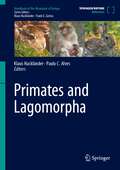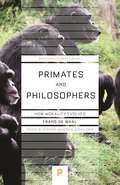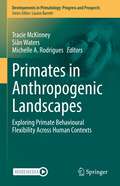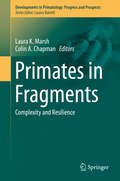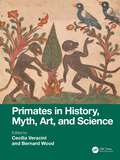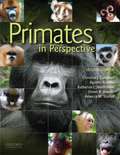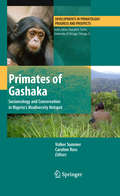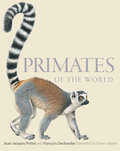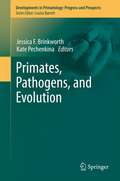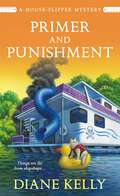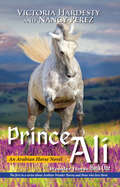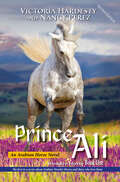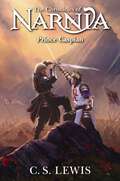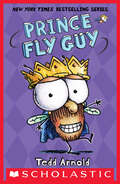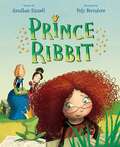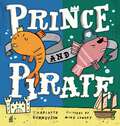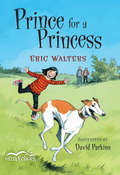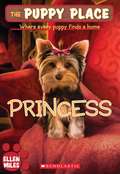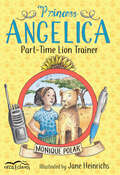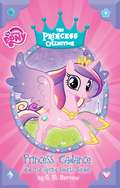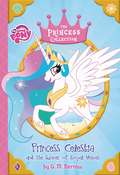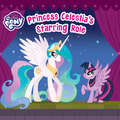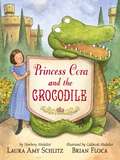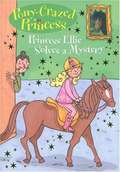- Table View
- List View
Primates and Lagomorpha (Handbook of the Mammals of Europe)
by Paulo C. Alves Klaus HackländerThis volume provides comprehensive overviews of the primate’s and each lagomorph species’ biology including palaeontology, physiology, genetics, reproduction and development, ecology, habitat, diet, mortality and age determination. Their economic significance and management, as well as future challenges for research and management are also addressed. Each chapter includes a distribution map, a photograph of the animal and key literature. This authoritative volume of the Handbook of the Mammals of Europe is a timely and detailed compilation of all European primates and lagomorphs and will appeal to academics and students in mammal research, as well as to professionals dealing with mammal management, including control, use and conservation.
Primates and Philosophers: How Morality Evolved (Princeton Science Library #43)
by Frans de WaalCan virtuous behavior be explained by nature, and not by human rational choice? "It's the animal in us," we often hear when we've been bad. But why not when we're good? Primates and Philosophers tackles this question by exploring the biological foundations of one of humanity's most valued traits: morality. In this provocative book, renowned primatologist Frans de Waal argues that modern-day evolutionary biology takes far too dim a view of the natural world, emphasizing our "selfish" genes and reinforcing our habit of labeling ethical behavior as humane and the less civilized as animalistic. Seeking the origin of human morality not in evolution but in human culture, science insists that we are moral by choice, not by nature. Citing remarkable evidence based on his extensive research of primate behavior, de Waal attacks "Veneer Theory," which posits morality as a thin overlay on an otherwise nasty nature. He explains how we evolved from a long line of animals that care for the weak and build cooperation with reciprocal transactions. Drawing on Darwin, recent scientific advances, and his extensive research of primate behavior, de Waal demonstrates a strong continuity between human and animal behavior. He probes issues such as anthropomorphism and human responsibilities toward animals. His compelling account of how human morality evolved out of mammalian society will fascinate anyone who has ever wondered about the origins and reach of human goodness. Based on the Tanner Lectures de Waal delivered at Princeton University's Center for Human Values in 2004, Primates and Philosophers includes responses by the philosophers Peter Singer, Christine M. Korsgaard, and Philip Kitcher and the science writer Robert Wright. They press de Waal to clarify the differences between humans and other animals, yielding a lively debate that will fascinate all those who wonder about the origins and reach of human goodness.
Primates in Anthropogenic Landscapes: Exploring Primate Behavioural Flexibility Across Human Contexts (Developments in Primatology: Progress and Prospects)
by Tracie McKinney Siân Waters Michelle A. RodriguesThe field of primatology has expanded substantially in the last twenty years, particularly with regard to studies of primates in human-altered landscapes. This text aims to review the recent literature on anthropogenic (of human origin) influences on non-human primates, bringing an overview of this important area of primatology together for students. Chapters are grouped into three sections, representing the many ways anthropogenic activities affect primate populations. The first section, ‘Human Influences on Primate Habitat’, covers ways in which wild primates are affected by human actions, including forest fragmentation, climate change, and the presence of dogs. Section two, ‘Primates in Human-Dominated Landscapes’, looks at situations where non-human primates and humans share space; this includes primates in urban environments, primate tourism, and primates in agroecosystems. The final section, ‘Primates in Captivity’, looks at primate behaviour and welfare in captive situations, including zoos, the primate pet trade, and in entertainment.
Primates in Fragments
by Laura K. Marsh Colin A. ChapmanThis book is number two in a series for Primates in Fragments. In this volume, ten years after the first http://www. springer. com/social+sciences/anthropology+%26+archaeology/book/978-0-306-47696-9, we continue to address issues regarding primates within a fractured landscape. There are seven sections based on specific categories of primates in fragments. In the Introductory section, authors discuss the issues surrounding primates in remnant habitats as well as encourage discussion about what we mean by fragmentation on a landscape scale. In the Long-Term and Regional Studies section, authors present information on changes that have occurred during longer studies as well as changes that have occurred over regions. In the Landscape, Metapopulations and the Matrix section, authors cover topics from dry to moist forests, and from metapopulations to single species use of multiple fragments locations. In Feeding and Behavioral Ecology, authors take a closer look at the flexibility and responsiveness of primates in fragments in terms of their food choices, resource use, and behavioral changes. In Endemic, Endangered, and Nocturnal Primates authors uncover details involving critical primates living in major city centers to the heights of the Himalayas. In Genetics, Disease and Parasites authors cover topics including population viability, disease and parasite transmission between primates in fragments and humans. Finally, in the Conservation and Ecology: Threats and Management section, we synthesize information in this volume and make recommendations for the future of work in this field and the survivability of primates in fragments.
Primates in History, Myth, Art, and Science
by Bernard Wood Cecilia VeraciniNon-human primates (hereafter just primates) play a special role in human societies, especially in regions where modern humans and primates co-exist. Primates feature in myths and legends and in traditional indigenous knowledge. Explorers observed them in the wild and brought them, at great cost, to Europe. There they were valued as pets and for display, their images featured in art and architecture, and where they were literally teased apart by scientists. The international team of contributors to this book draws these different perspectives together to show how primates helped humans better understand their own place in nature. The book will be of interest to undergraduate and graduate students as well scholars in disciplines ranging from anthropology to art history.Key features: Includes contributions from an international team of historians and natural scientists Integrates various perspectives and perceptions of non-human primates across time and place Summarizes the place of non-human primates in science, art and culture Includes rare early illustrations
Primates in Perspective (2nd Edition)
by Agustin Fuentes Christina J. Campbell Katherine C. Mackinnon Rebecca M. Stumpf Simon K. BearderFeaturing forty-seven original essays by seventy leading researchers, Primates in Perspective, Second Edition, offers a comprehensive and contemporary overview of all major areas of primatology. Thoroughly revised and updated throughout, the second edition offers a diversity of theoretical positions on such topics as reproduction, ecology, and social behavior and intelligence. Primates in Perspective, Second Edition, is ideal for introductory primatology courses and can also be used in upper-division behavior and conservation courses. Additionally, it is an essential reference for primate researchers.
Primates of Gashaka
by Volker Sommer Caroline RossThe Gashaka Primate Project has grown into one of the largest research and conservation activities in West Africa. At present, it keeps going on the initiative of the editors of this volume and their academic home institutions.The appearance of this volume marks the 10th anniversary of the Gashaka Primate Project
Primates of the World: An Illustrated Guide
by Robert Martin Jean-Jacques Petter Francois DesbordesThis guide to the world's primates covers nearly 300 species, from the feather-light and solitary pygmy mouse lemurs of Madagascar--among the smallest primates known to exist--to the regal mountain gorillas of Africa. The book is organized by region and spans every family of primates on Earth.
Primates, Pathogens, and Evolution
by Kate Pechenkina Jessica F. BrinkworthThe immune systems of human and non-human primates have diverged over time, such that some species differ considerably in their susceptibility, symptoms, and survival of particular infectious diseases. Variation in primate immunity is such that major human pathogens - such as immunodeficiency viruses, herpesviruses and malaria-inducing species of Plasmodium - elicit striking differences in immune response between closely related species and within primate populations. These differences in immunity are the outcome of complex evolutionary processes that include interactions between the host, its pathogens and symbiont/commensal organisms. The success of some pathogens in establishing persistent infections in humans and other primates has been determined not just by the molecular evolution of the pathogen and its interactions with the host, but also by the evolution of primate behavior and ecology, microflora, immune factors and the evolution of other biological systems. To explore how interactions between primates and their pathogens has shaped their mutual molecular evolution, Primates, Pathogens and Evolution brings together research that explores comparative primate immune function, the emergence of major and neglected primate diseases, primate-microorganism molecular interactions, and related topics. This book will be of interest to anyone curious as to why infectious diseases manifest differently in humans and their closest relatives. It will be of particular interest to scholars specializing in human and non-human primate evolution, epidemiology and immunology, and disease ecology. Primates, Pathogens and Evolution offers an overview and discussion of current findings on differences in the molecular mechanics of primate immune response, as well as on pathogen-mediated primate evolution and human and non-human primate health.
Primer and Punishment: A House-Flipper Mystery (A House-Flipper Mystery #5)
by Diane KellyPrimer and Punishment marks the fifth in the delightful cozy mystery series from Diane Kelly set in Nashville, Tennessee. Whitney Whitaker has a knack for nailing down murderers . . . but this time she might just come unmoored. Carpenter Whitney Whitaker and her cousin Buck are looking once again to rehab and resell a house, only this particular house is made of fiberglass, floats, and has been dubbed the Skinny Dipper. The old houseboat sure could use some work, but the unusual project has Whitney bubbling with excitement. The charming and handsome Grant Hardisty lives on the cabin cruiser in the adjacent slip, but the cousins soon learn he’s left a half dozen angry ex-wives in his wake and made enemies of all sorts of unsavory folks. The man is clearly caught in an increasingly dangerous current with no life preserver in sight. Whitney and Buck are spraying primer on their houseboat when—KABOOM!—Grant’s boat blows sky high with the man himself inside. Detective Collin Flynn has no shortage of suspects, but the waters become muddied when several of them confess to the crime. Is one of those who confessed truly guilty, or are they taking a dive for someone else? When anonymous threats are made against the cousins, Whitney must quickly determine who killed their neighbor at the lake, or she and Buck might also be sunk.
Prince Ali: An Arabian Horse Novel
by Victoria Hardesty and Nancy PerezPrince Ali had everything: talent, charisma, and a devoted best friend, Becky Howard. He won every time he set a hoof in a show ring. He garnered more fans from personal and TV appearances. Becky was with him every step of the way, even riding him in the Swallows Day Parade in their hometown, San Juan Capistrano. Disaster struck when two thugs put Becky in a coma, drugged him and dragged Prince Ali off to sell for diabolical purposes. When their buyer realized who Ali was, he nixed the deal. That landed the pampered show horse high in the mountains in late March. One night, a week later, he discovered the corral gate unlatched. Prince Ali mustered every ounce of strength, courage, and stamina he had to walk into the wilderness searching for the best friend he couldn't live without.
Prince Ali: An Arabian Horse Novel
by Victoria Hardesty and Nancy PerezPrince Ali had everything: talent, charisma, and a devoted best friend, Becky Howard. He won every time he set a hoof in a show ring. He garnered more fans from personal and TV appearances. Becky was with him every step of the way, even riding him in the Swallows Day Parade in their hometown, San Juan Capistrano. Disaster struck when two thugs put Becky in a coma, drugged him and dragged Prince Ali off to sell for diabolical purposes. When their buyer realized who Ali was, he nixed the deal. That landed the pampered show horse high in the mountains in late March. One night, a week later, he discovered the corral gate unlatched. Prince Ali mustered every ounce of strength, courage, and stamina he had to walk into the wilderness searching for the best friend he couldn't live without.
Prince Caspian: The Return to Narnia (Chronicles of Narnia #4)
by C. S. LewisIllustrations in this ebook appear in vibrant full color on a full-color ebook device and in rich black and white on all other devices.Narnia . . . where animals talk . . . where trees walk . . . where a battle is about to begin.A prince denied his rightful throne gathers an army in a desperate attempt to rid his land of a false king. But in the end, it is a battle of honor between two men alone that will decide the fate of an entire world.Prince Caspian is the fourth book in C. S. Lewis’s The Chronicles of Narnia, a series that has become part of the canon of classic literature, drawing readers of all ages into a magical land with unforgettable characters for over sixty years. This is a stand-alone novel, but if you would like to see more of Lucy and Edmund’s adventures, read The Voyage of the Dawn Treader, the fifth book in The Chronicles of Narnia.
Prince Fly Guy (Fly Guy #15)
by Tedd ArnoldOnce upon a time, Buzz writes a fairy tale for a class assignment and Fly Guy becomes a handsome prince!In the latest installment of Tedd Arnold's NEW YORK TIMES bestselling Fly Guy series, Buzz has a homework assignment to write a fairy tale and he asks Fly Guy to help. Fly Guy doesn't like to think of himself as some of Buzz's suggestions--an ugly troll, a smelly pig herder--so he becomes a handsome prince instead! Prince Fly Guy flies to a dark castle, fends off a giant, and rescues a beautiful princess.Even reluctant readers will enjoy this fun, zany story about Fly Guy's adventure in a fairy tale!
Prince Ribbit
by Jonathan Emmett Poly Bernatene<p>Enchanted prince or just a plain old frog? Pucker up, princesses! There’s only one way to find out . . . <p>Fairy tales are just stories―or so Princess Martha believes. But when her sisters meet a talking frog, they’re convinced that giving him the royal treatment will turn him into Prince Charming. After all, that’s what happens in their story books. Martha isn’t so sure. The more she sees of Prince Ribbit, the more suspicious she becomes. Armed with the facts, Martha sets out to expose Prince Ribbit and prove to her sisters that “just because it’s in a book doesn’t mean it’s true.” But before “The End,” Princess Martha might just learn that lesson for herself! <p>Jonathan Emmett’s clever twist on the “The Frog Prince” pits a spunky, bespectacled princess against a sly amphibian to teach a charming lesson on the pitfalls of trusting everything you read.</p>
Prince Sacha's Fierce, Fabulous, Fancy Day
by Jon LauPrince Sacha doesn't have anything to wear to the royal parade -- or does he? A brilliant, beautiful, funny, and modern twist on The Emperor's New Clothes!Kids of all ages will embrace debut author-artist Jon Lau's humorous and stunning tale, which reminds everyone to be proud of who they are and celebrate the things that make them unique -- no matter what others think.Prince Sacha has commissioned all the dress designers in the kingdom to create the most marvelous creation for him to wear for the annual Royal Prince Parade. But nobody is up for the job until a cunning rabbit gown maker and his siblings show our royal bear an extraordinary garment that is quite exceptional... or is it?
Prince and Pirate
by Charlotte GunnufsonWhen two little fish with big personalities have to share the same tank, there are rough seas ahead! Prince and Pirate are proud masters of their very own fishbowls, and life goes along swimmingly—until they&’re scooped up and plopped into shared waters. Prince is horrified to find this cheeky cod trespassing in his kingdom. Pirate is sure this scurvy sea slug has come to plunder his treasure. Thus, a battle of regal sneers, seaworthy stink-eyes, and off-the-hook insults begins. Prince and Pirate&’s hilarious duel for territory will elicit gales of giggles, hearty guffaws, and heartfelt smiles. Just when it seems their struggle might end in a silly stalemate, a little surprise convinces them to find a way to get along—swimmingly.
Prince for a Princess (Orca Echoes)
by Eric WaltersSeven-year-old Christina desperately wants a dog. When she visits a kennel with her parents, she comes home with Prince, a greyhound recently retired from his champion racing career. Christina is thrilled and spends all her time with her new pal. They are like two peas in a pod. But one day, when Prince is left alone in the backyard, he escapes. Christina's mother searches everywhere for him only to find him at the schoolyard gate waiting for Christina. Promising never to leave him alone in the backyard again, her father brings home a little Chihuahua named Chancho. Now Prince will always have a companion to play with. The epub edition of this title is fully accessible.
Princess (The Puppy Place #12)
by Ellen MilesCharles volunteers to care for Princess, a spoiled but enticing Yorkie pup. Petersons get tired of Princess's privileged ways. How will Charles ever find the right family for this pup?
Princess Angelica, Part-Time Lion Trainer (Orca Echoes)
by Monique PolakOur favorite pretend princess, Angelica, aka Jelly, is back! A case of mistaken identity, a wild imagination and a love of storytelling leads Jelly to tell her friend Joon and the new kid she's just met, Leo, that she's a part-time lion trainer at the local animal rescue center. Her inventiveness has them completely convinced, but things get a bit more complicated when the resident lioness, Mwezi, escapes from her enclosure and the kids look to Jelly’s "expertise" to save the day. The epub edition of this title is fully accessible.
Princess Cadance and the Spring Hearts Garden (The Princess Collection)
by G. M. BerrowLove is in the air--or at least it should be on Hearts and Hooves Day! But when an outbreak of the pony sniffles turns this loving holiday into a disaster, Princess Cadance must find a way to get everypony through the winter blues. And what better way than a Garden Hearts Celebration? With helping hooves from Crystal Empire School students, Cadance creates a garden of beautiful wonders to lift spirits. However, not long after the festival's in blood, strange things start to happen. Some ponies can't stop giggling and others seem hypnotized. It's up to Cadance to find the root of the problem! © Hasbro 2016. All Rights Reserved.
Princess Celestia and the Summer of Royal Waves: My Little Pony (The Princess Collection)
by HasbroAn original paper-over-board My Little Pony chapter book featuring Princess Celestia!
Princess Celestia's Starring Role (My Little Pony)
by Louise AlexanderIt's the 1,111th anniversary of when Princess Celestia first raised the sun, and Twilight Sparkle knows just how to celebrate: with a play starring Princess Celestia herself! The only problem is Princess Celestia can't act! Can Twilight Sparkle find a way to break it to her mentor and save the show?This storybook is based on an episode of My Little Pony: Friendship is Magic, as seen on Discovery Family and Netflix.© 2019 Hasbro. All Rights Reserved.
Princess Cora and the Crocodile
by Laura SchlitzPrincess Cora is sick of boring lessons. She's sick of running in circles around the dungeon gym. She's sick, sick, sick of taking three baths a day. And her parents won't let her have a dog. But when she writes to her fairy godmother for help, she doesn't expect that help to come in the form of a crocodile-a crocodile who does not behave properly.
Princess Ellie Solves a Mystery (Pony-Crazed Princess #8)
by Diana KimptonPrincess Ellie is absolutely, positively crazy about her ponies! She has four perfect ponies and the entire palace grounds in which to ride them.
